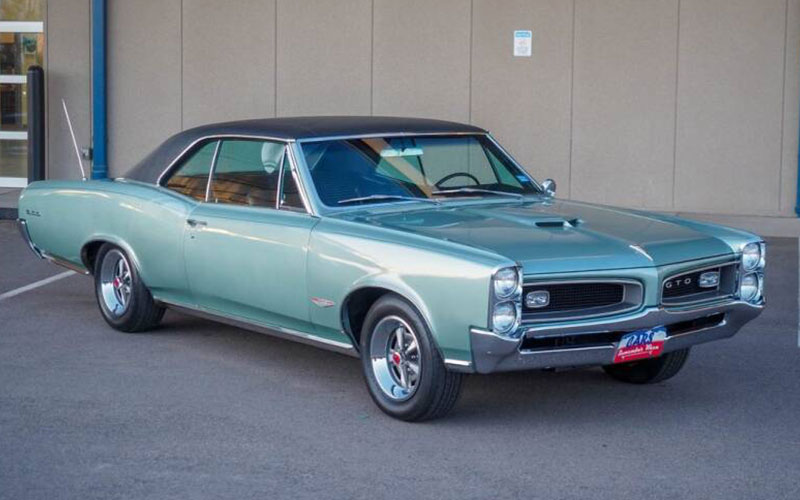Retro Review: Pontiac GTO
The Pontiac GTO kick started the automotive revolution that was the muscle car era of the 1960s and ‘70s. Here’s what makes the GTO the GOAT.
1964 Pontiac GTO – carsforsale.com | Shop Pontiac GTO on Carsforsale.com
The GTO was First Among Equals
Ask most car people what the first muscle car was, and they’ll give you a number of different answers. Some will tell you it was the 1949 Olds Rocket 88 or maybe the ’55 Chevy with its pushrod V8, or perhaps the ’57 Rambler Rebel running its 327 V8. The most common answer you’ll get, however, is the 1964 Pontiac GTO.
While these earlier cars did their part to pioneer the formula of mid-size coupe motivated by a powerful V8, they did not do what the GTO did, that is, be the first car to kick off an automotive revolution. The GTO ignited the muscle car craze of the 1960s and early ‘70s. The now classic long hood-short deck packaging and heaps of horsepower combined with democratizing affordability to allow even high school kids to access a new level of automotive performance.
Launching the Muscle Car

Where Lee Iacocca had seen an opening for a fun, affordable sports car, Pontiac’s John DeLorean had seen a market ripe for real performance (yes, that DeLorean, of the DMC-12 aka the Back to the Future car). This naturally dovetailed with Pontiac’s market identity as a performance brand. In the early 1960s, the ambitious DeLorean and his team wanted Pontiac to build a leaner, meaner sports car for the masses. The only trouble was GM was part of the AMA’s (Automobile Manufacturers’ Association) racing ban and internal rules tied weight and displacement together, limiting cars to one cubic inch for every 10 lbs. of weight.
This would have severely limited the prospects for the kind of high-output sports car DeLorean and his team at Pontiac were envisioning. Their solution? Rather than offer the car as a standalone model subject to the 1×10-lbs. rule, they would offer the new GTO as a special trim package of the Tempest-based Pontiac Le Mans, which sidestepped GM’s prohibitive stipulations.
The similarity between the Pontiac GTO’s name and that of the famous Ferrari racecar, the 250 GTO, is not coincidental. DeLorean wanted to give his new car a motorsport connotation and “borrowed” the GTO name, which stood for Gran Turismo Omologato and translates to Homologated Grand Touring.
The Pontiac GTO debuted in September of 1963; the era of the muscle car had begun.
From Le Mans to GTO

Under GM’s displacement rule, the Le Mans GTO would have been limited to an engine no larger than 330 cubic inches, but by selling the GTO as a trim package, the new car could run the motor desired by DeLorean, the Pontiac 389 V8. This motor produced 325 horsepower stock and could be optioned with a “tri-power” carb setup that offered up to 348 horsepower. The GTO package also added a pair of hood scoops, a four-barrel carb, a three-speed manual, and wider than stock wheels. Car & Driver recorded a zero to sixty time of just 4.6 seconds with the 1964 GTO, though there is speculation that the test car Pontiac sent them was not entirely stock. Spurious or not, the GTO had set a high target for all muscle cars to come.
The GTO became its own nameplate for the 1966 model year, adding new styling along the way that introduced Coke-bottle curves above the rear fender. 1966 would prove the GTO’s peak, selling 96,946 units that year. The following year brought even more significant changes. In addition to exterior revisions to the grille and taillights, the biggest change was the introduction of a new 400 cu.-in. V8 as the standard engine. This motor produced between 335 and 360 horsepower, depending on the carb setup employed. The GTO’s hood tachometer was also introduced this year as a dealer option (becoming a factory option the following year).
The Judge, Ram Air, and the 2nd Gen GTO

The Pontiac GTO’s second generation, starting with the 1968 model year, is remembered for its stunning looks, numerous performance upgrades, and one of the most famous muscle car variants of all time, The Judge. With the advent of its second generation, the Pontiac GTO got smaller, cutting three inches from the wheelbase and 5.9 overall, and exterior updates that included optional hidden headlights (very cool). The 400 cu.-in. V8 was carried over, now making a minimum of 350 horsepower and up to 360. A new Ram Air II upgrade added a 041 cam, new cylinder heads, and a round port exhaust.
The big news for the gen-two GTO was a new trim package called “The Judge” named after a character from the sketch comedy show Laugh In. The Judge was originally envisioned as a stripped-down version of the GTO but in the end, it became the car’s highest trim option. It added a Hurst shifter, Rally II wheels, a rear spoiler, and most importantly, a Ram Air version of the 400 cu.-in. V8. Ram Air III and Ram Air IV iterations offered 366 and 370 horsepower, respectively.
A new 455 V8 was introduced for the 1970 model year, along with a new front-end design that became one of its most iconic looks. The 455 V8 was a potent engine offering 360 horsepower and a thundering 500 lb.-ft. of torque.
As nice as the 1970 model looked or how torquey the 455 was, the worm was beginning to turn for both the GTO and the muscle car segment writ large. Sky high insurance rates and looming emissions and fuel economy regulations began to undercut power and performance numbers. The Ram Air options were dropped for 1971 and output from the 400 V8 cut to just 255 horsepower, while the 455 mustered between 260 and 310 horsepower.
With both power and sales down, the 1972 the GTO was moved back under the Le Mans name as a package option.
’73 and ’74 – GTO Gets Slow

The brief 1973 generation and equally truncated 1974 generation GTOs saw the car evolve both visually and mechanically in the wrong direction (though the NACA ducts sure are nifty). For 1973, the 400 V8 was making 230 horsepower while the 455 offered just 250 horsepower. That the GTO was merely a package option didn’t help sales which came in just under 5,000 units for 1973.
The 1974 version saw the Le Mans shift to a new X-body platform and the addition of an optional hatchback body style. A new 350 cu.-in. V8 imbued the GTO with an anemic 200 horsepower and a zero to sixty time of 9.3 seconds. And yet, the ‘74 GTO fared better than the ’73 car, moving just over 7,000 units. A modest improvement in sales couldn’t stave off the GTO’s inevitable cancellation following the 1974 model year.
The Holden GTO

Flash forward to 2004 and the muscle car had come full circle with performance finally catching up to fuel economy and emissions standards to produce some of most powerful American sports cars in more than a generation. One such car was the Holden Morano, built by GM’s Australian subsidiary. The Morano ran the Corvette’s LS1 V8 in a tight, muscle car package. The Morano so impressed GM’s Bob Lutz that he set to work making the Morano a captive import to the US under the Pontiac brand. Resurrecting the GTO name was the next logical step, or so Lutz assumed.
The new GTO did indeed offer performance worthy of its predecessor. The 5.7L LS1 V8 in base form made a stout 350 horsepower and 494 lb.-ft. of torque allowing the GTO to make zero to sixty in 5.3 seconds. The 6.0L LS2, introduced in 2005, upped the ante with 400 horsepower and 542 lb.-ft. for a zero to sixty of just 4.7 seconds. And while the new GTO had the goods under the hood, the car ended up more expensive than Pontiac had hopped, depressing sales that were already under assault by styling that most critics and car buyers deemed dull to the point of anonymity. Not exactly a recipe for success for a muscle car. Just 41,000 of the fifth-gen GTOs sold in three years of production, concluding following the 2006 model year.











I owned a 2004 GTO, and it was by far, the best car I have ever owned. Much better handling than any 60’s or 70’s muscle car I have owned. Motor was strong as well. I would love to see my old 2004 up against a stock Judge. I am sure the Holden would win in any format race, Drag or road race.